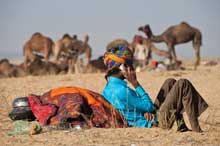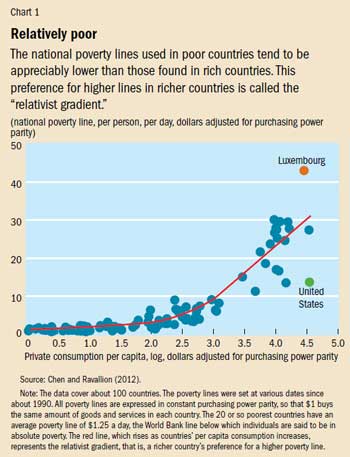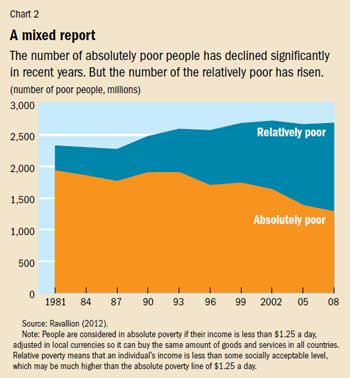A Relative Question
Finance & Development, December 2012, Vol. 49, No. 4
The developing world is reevaluating what it means to be poor

Rising average living standards in many developing countries have triggered a reassessment of what it means to be considered poor. In response, some of those countries have increased their poverty lines (the income level below which a person or household is deemed poor). For example, China recently doubled its national poverty line from 90 cents a day to $1.80 (adjusted to reflect constant 2005 purchasing power). Other countries—including Colombia, India, Mexico, Peru, and Vietnam—have also recently revised their poverty lines upward.
These revisions are hardly surprising. The poverty measure in any given setting will be accepted only if it accords reasonably well with prevailing ideas of what poverty means in that setting. Sustained overall growth will undoubtedly result in more countries raising their standards. The same thing happened over time in most of today’s rich countries.
What does this mean for how we should monitor overall progress against poverty? Should the poverty line also vary with average income?
Assessing progress
These questions hark back to an old debate—whether poverty is absolute or relative. An absolute poverty line is intended to represent constant purchasing power over commodities in different places and at different dates. An example is the World Bank’s international poverty line of $1.25 a day, which is converted to local currencies at so-called purchasing power parity (PPP). By contrast, prevailing relative lines are set at a constant proportion of the country- or year-specific mean (or median) household consumption or income per person (or equivalent single adult). The poverty lines typically used in western Europe are examples.
The choice of method matters to assessments of progress against poverty and to long-standing policy debates about the potential for reducing poverty through economic growth. Indeed, when the poverty line is fixed in real terms, any standard poverty measure will automatically fall during a growth period in which all incomes rise proportionally. But the same growth process will have no effect on the poverty measure when the line is set at a constant percentage of average income or consumption.

Low- and middle-income countries have tended to favor absolute lines, while most high-income countries have preferred relative lines. Richer countries also tend to use higher poverty lines. This preference for a higher national poverty line can be called the “relativist gradient.”
Chart 1 plots the national poverty lines for about 100 countries against consumption per capita, both at PPP. The highest line is in Luxembourg, at $43 a day, while the United States, with a similar level of average consumption to Luxembourg, has a $13-a-day line. The relativist gradient is evident as consumption levels decline. The average poverty line of the poorest 20 or so countries is $1.25 a day—which is how the World Bank’s international absolute line was set. Even among developing countries that use absolute lines, countries with higher average incomes tend to have higher real lines. Across countries it seems that poverty is indeed relative.
A social norm
The question for development specialists is whether global poverty monitoring should allow the poverty line to vary with average income. The answer depends on how the gradient in national lines in Chart 1 is interpreted.
One can think of a poverty line as the monetary equivalent of an underlying concept of human welfare in a specific setting—a social norm that can vary from one setting to another. The poverty measure in any given setting will be accepted only if it accords reasonably well with prevailing ideas of what poverty means in that setting. Norms differ between rich and poor societies and evolve over time in growing economies. But using a lower real poverty line in poorer countries will mean that two people judged to have the same standard of living—that is their income can buy an equivalent assortment of goods and services—end up being treated differently depending on where or when they live. This inconsistency has motivated the past emphasis on measuring absolute poverty using a common real poverty line, such as $1.25 a day.
However, there is another interpretation of why richer countries have higher poverty lines that is grounded in the idea that there are “social effects” on welfare. The absolute approach views individual welfare as dependent on an individual’s own consumption. In this view, where a person lives is irrelevant to whether that person is deemed to be poor because the absolute line represents the same real level of consumption across countries. A relative line, by contrast, encompasses certain social determinants of welfare that vary with the context. In this view, poverty lines reflect the welfare effects of relative deprivation—that even though two people have the same real income, the one living in the richer country will feel worse off—and the costs of social inclusion, namely the extra expenditures necessary to participate in a rich society compared with a poor one. Research in various fields—anthropology, psychology, and economics—has found evidence consistent with the existence of such social effects on individual welfare.
So there are two competing explanations for Chart 1. Under the social norms interpretation, individual welfare depends solely on a person’s own consumption. The relativist gradient stems from a tendency for richer countries to use higher welfare norms in deciding who is poor.
The social effects interpretation does not require different norms, but postulates instead that living in a richer country requires a higher level of consumption to attain the same level of welfare. Then the welfare-consistent poverty lines—anchored to a common level of welfare—will tend to rise with the average consumption of a country.
This admittedly subtle theoretical distinction between social norms of welfare and social effects on welfare has dramatically different implications for global poverty measurement. The social norms interpretation points us toward absolute measures, while the social effects interpretation points us toward some concept of relative poverty. The uncertainty about which interpretation is right makes it essential to consider both approaches when measuring global poverty.
A global measure of relative poverty
The question for analysts then is how to devise a reasonable global measure of relative poverty, to complement prevailing absolute measures. Setting relative poverty at a constant proportion of the mean income requires implausible assumptions. In particular, it requires either the assumption that people are concerned solely with relative deprivation (so that their own consumption does not matter independent of their relative consumption) or the assumption that the costs of social inclusion can be nearly zero in the poorest places.
World Bank researchers have developed new poverty measures that take social effects on welfare seriously (Ravallion and Chen, 2011). Technically, these are called “weakly relative” measures, meaning that the poverty line rises with average income but not as a constant proportion of that income. It can also be thought of as an inverse measure of “social inclusion,” in that fewer people living below the weakly relative line means that more people have attained the social inclusion needs deemed relevant to the society in which they live. Each country then has two poverty lines, namely the absolute $1.25 a day line and a higher (or, at least, no lower) line intended to reflect higher costs of social inclusion in the country concerned. In the poorest of countries, the second line is also an absolute measure.
Weakly relative measures have been constructed that are consistent with the relativist gradient described above. And they are consistent with evidence on subjective perceptions of welfare in developing countries. Weak relativity is also suggested by the recent signs that the idea of what poverty means in developing countries is changing. This does not necessarily reflect a higher welfare threshold—it may instead be that a higher income is deemed necessary to attain the same level of welfare.
When this new approach is applied to the data, we find that 47 percent—slightly less than half—of the developing world’s population was relatively poor in 2008. Of that 47 percent, 22 percent lived below the absolute line of $1.25 a day.
To put this in perspective, the corresponding relative poverty rate for high-income countries (calculated on a consistent basis) is 24 percent for 2008. However, as best can be determined from the available data, no one in that 24 percent in high-income countries lived below $1.25 a day (though some very poor people may not have been picked up in the sample surveys, notably the homeless).
We find that the incidence of relative poverty has fallen in the developing world, from 63 percent of the population in 1981 to 47 percent in 2008 (Chen and Ravallion, 2012). But even though the proportion declined, a growing population meant that the total number of relatively poor people rose by about 360 million over that period.
At the same time, there has been a decline in the incidence of absolute poverty in the developing world. The overall percentage of the population living below $1.25 a day was 52 percent in 1981, compared with 22 percent in 2008. In 2008, 1.3 billion people lived below $1.25 a day, compared with 1.9 billion in 1981. Progress has been uneven across regions, but absolute poverty counts fell in all regions during the 2000s.

Chart 2 shows the numbers of absolutely and relatively poor people in the developing world between 1981 and 2008. More than 80 percent of the relatively poor in 1981 were absolutely poor, but by 2008 the proportion had fallen to less than half.
So a substantial increase in the number of people who are relatively poor but no longer absolutely poor came hand in hand with the developing world’s success against absolute poverty. Economic growth has generally meant a lower absolute poverty rate, but over time it has also meant that in many developing countries relative considerations have become more important. The relative measure of poverty is naturally less responsive to economic growth and puts a somewhat higher weight on inequality. Rising numbers of people who are relatively poor can thus be seen as the other side of falling numbers of those who are absolutely poor. Success has come with a change in what it means to be successful.
Fighting absolute poverty
It would not be fair to the more than 1 billion people who still live on less than $1.25 a day to abandon the emphasis on fighting absolute poverty. Eliminating such extreme poverty must remain the global development community’s number one priority. But the world is changing rapidly. The convergence in living standards across the globe is accompanied by emerging convergence in our ideas about what poverty means—although it will be a long time before, say, China’s poverty line reaches the U.S. line, let alone Luxembourg’s. New poverty targets will undoubtedly emerge that reflect these new perceptions. We can recognize that fact, and recognize that success against absolute poverty will probably swell the ranks of the relatively poor, without diverting our efforts at bringing the poorest people in the world out of extreme poverty. ■
References
Chen, Shaohua, and Martin Ravallion, 2012, “More Relatively-Poor People in a Less Absolutely-Poor World,” World Bank Policy Research Working Paper 6114 (Washington).
Ravallion, Martin, 2012, “Poverty Lines across the World,” in The Oxford Handbook of the Economics of Poverty, ed. by Philip N. Jefferson (New York: Oxford University Press USA).
Ravallion, Martin, and Shaohua Chen, 2011, “Weakly Relative Poverty,” Review of Economics and Statistics, Vol. 93, No. 4, pp. 1251–61.


